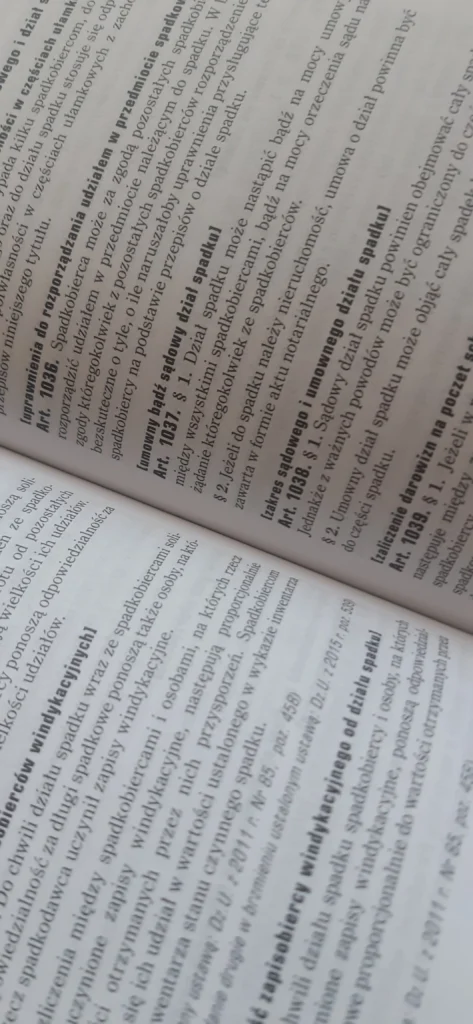The rules of inheritance in Poland define the order of succession when a person residing in Poland passes away. However, understanding these rules is only the first step – properly settling an inheritance usually requires a formal probate process.
Generally, Polish courts (and/or Polish notaries public) have jurisdiction over probate proceedings if:
- The deceased had habitual residence at the time of their death; or
- The deceased owned real estate located in Poland (in such cases, probate concerning that property must be conducted in Poland).
Structure of the probate process
The probate process in Poland generally consists of two separate phases:
- Confirmation of Inheritance Rights – In this phase, the legal heirs and their respective shares in the estate are identified. The court does not examine the composition of the estate at this stage—it focuses solely on determining who is entitled to inherit.
- Division of the Estate – Once the heirs are confirmed, they may proceed to divide the inherited property.
Although these are distinct legal proceedings, it is possible to file a single application for both. In such cases, the court will issue two separate decisions – first confirming the heirs, then ruling on the division of the estate.

Typically, probate proceedings are handled by district courts. However, if there is no conflict among the heirs, all parties are present, and the matter is straightforward, the proceedings may also be conducted before a notary public.
Determining the Heirs
Ownership of the deceased’s property legally passes to the heirs at the moment of death. However, in order to perform any legal actions regarding the estate – such as selling property, transferring funds from bank accounts, or updating land registers – the court must first confirm the acquisition of inheritance rights.
In this initial phase of probate, the court or notary applies the relevant inheritance rules (statutory or testamentary) to determine who is entitled to inherit. Several factors are considered during this process, including:
- Whether the deceased left a valid will;
- Whether the potential heirs accepted or renounced the inheritance within the statutory deadline;
- Whether any of the heirs were disinherited.
It is crucial that all potential heirs are properly identified and included in the proceedings. The application should therefore include a detailed description of the deceased’s family relationships – even if a will exists. Once the court issues a ruling in the proceedings for the declaration of inheritance, it is very difficult to overturn. The ruling can be annulled only in exceptional cases – for example, if the applicant deliberately misled the court by omitting heirs.
It is important to remember that the issuance of the court’s decision declaring the acquisition of inheritance triggers the deadline for fulfilling inheritance tax obligations.
Division of the Estate
Polish inheritance law follows the principle of universal succession, meaning that the moment the deceased passes away the heirs automatically acquire their rights and obligations in accordance with their inheritance shares. While division of the estate is possible, it is not mandatory – heirs may choose to retain co-ownership of inherited assets.
If the heirs agree on how to divide the estate, they may enter into an inheritance agreement. It is important to comply with the required form of such agreements—for example, any agreement concerning real estate must be executed before a notary public.
If there is disagreement among the heirs or if some of them are not able to enter an agreement (for example they are minors, they live far away etc.), the division of assets will be decided by the court. There are three common ways the estate may be divided:
- Division in kind – For example, a single property may be divided into smaller parcels, with each heir receiving a portion;
- Allocation to one heir – One heir receives the entire estate and compensates the others for their shares;
- Sale of the estate – The estate is sold and the proceeds are distributed among the heirs.
Regardless of the method chosen, the court ensures that each heir receives property or compensation corresponding to the value of their legal share.
In assessing the value of each heir’s share and determining compensation, the court will also consider any investments or expenses incurred by the heirs in relation to the estate—for example, debts of the deceased paid by the heirs, renovation costs, or taxes paid after the acquisition of the estate. In Polish law, debts are considered just as much a part of the inheritance as assets.
Conclusion
Probate proceedings in Poland are designed to ensure a fair and transparent distribution of a deceased person’s estate. While the legal framework is relatively structured, the process can involve both formal court procedures and private agreements between heirs. Whether settled amicably or with court involvement, the ultimate goal is to confirm the rightful heirs and ensure that each receives their proper share—while honoring both the law and the wishes of the deceased.
The rules listed above are general and cover the most important aspects of the probate process in Poland. However, each case is unique and may involve different legal provisions. That’s why it’s essential to analyze the situation thoroughly before taking any steps. If you have any questions or need assistance from a lawyer, please do not hesitate to contact me via email (kotowska.kancelaria@gmail.com) or by phone (+48 608 393 623).
0 komentarzy